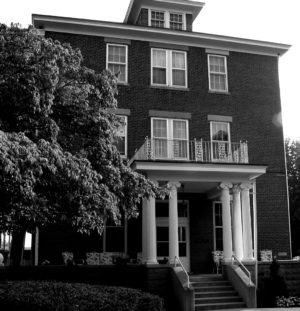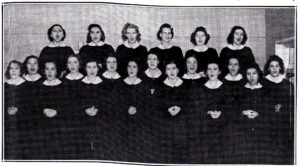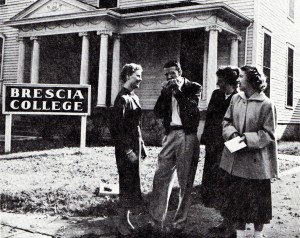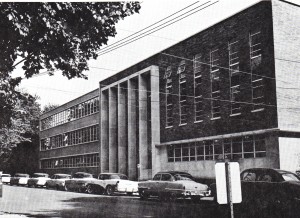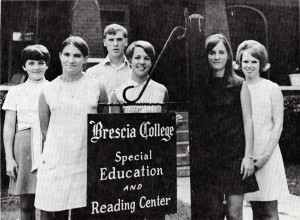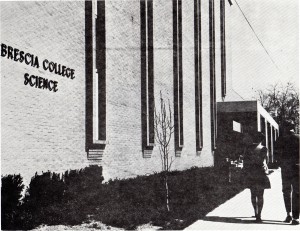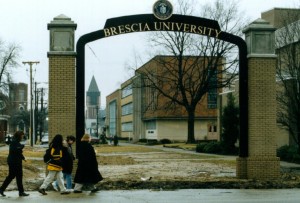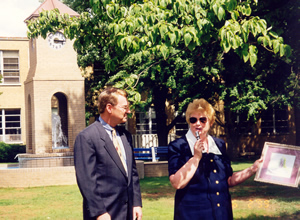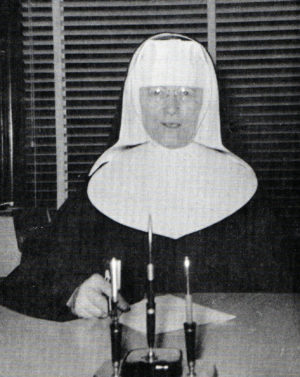
Sister Christina Eckmans was one of the first deans of Mount Saint Joseph Junior College and one of the original dedicated sisters that planted the seed of a women’s junior college in rural western Kentucky.
From the establishment of Mount Saint Joseph Academy in 1874, the Ursuline Sisters of Mount Saint Joseph strived to provide quality education to the young girls of western Kentucky. Starting in 1894, Mount Saint Joseph Academy offered postgraduate courses for young women preparing to take the state teachers’ examination. In 1919, the Ursuline Sisters started to provide summer sessions in college subjects, but only the sisters were admitted. In September 1925, the Mount Saint Joseph Junior College was established. It provided courses in English, Latin, Modern Languages, History, Math, Religion, Education, and Biology. The Junior College allowed students to be admitted as juniors in a four-year college with the two-year certificate. Registration started on Sept. 15 with 30 students enrolled. On April 19, 1926, the Junior College received a visit from Dr. W.D. Funkhouser, dean of the graduate school at the University of Kentucky, as a representative of the Accrediting Committee of the University. Dr. Funkhouser praised the academic work of the students and expressed approval along with his endorsement of the conduct of the Junior College. During the months of January and February 1927, the students were granted the right to maintain state, elementary, and high school teaching certificates with their Junior College credits. As the Junior College continued to grow, a bus line from Owensboro to St. Joseph made it possible for the Owensboro girls to attend as day students.
Saint Angela Hall was the main college dorm for students starting in 1930. This building still stands on Mount Saint Joseph campus.
A year after the bus line expansion, Mount Saint Joseph Junior College became an official member of the American Association of Junior Colleges and the Southern Association of Secondary Schools and Colleges. The courses at the Junior College were expanding as well. Students were allowed to submit requests for special courses like music, art, and public speaking. In September 1928, the Junior College welcomed 60 girls to the school and a new building for college use. The new room, in Saint Michael’s Hall, would be used for lecture and study. Before this room was added, the college courses were taught in Academy rooms that were not in use. January 1930 brought a new hall to the college students. Saint Angela Hall, built in 1914 for noviate training and faculty offices, was to be used as a college hall for the girls at Mount Saint Joseph Junior College. The first floor featured recreation, reading and dining rooms. The second floor held offices, a lounge, and assembly room. The last floor featured the students’ quarters. In 1932, the Junior College became a member of two more associations, the Southern Association of Colleges for Women and the Kentucky Association of Colleges and Universities.
The members of the College Choral and Dramatic Clubs broadcasted Christmas cheer on WOMI radio program in December 1938.
On Dec. 14, 1938, the College Choral and Dramatic Clubs featured a Christmas reading and play prologue on WOMI radio.The Dramatic Club performed the Christmas reading, ‘A Little Knock’, and play prologue, ‘The Most Beautiful Story’, while the Choral Club performed the background carols. In 1946, Mount St. Joseph Junior College began offering coeducational courses in Owensboro–at 120 W. Seventh Street. The Ursuline faculty commuted from Maple Mount to Owensboro. 1948 marked a new era for Mount Saint Joseph Junior College. A new sign saying BRESCIA COLLEGE was posted outside 120 W. Seventh Street in Owensboro to designate the new branch of Mount Saint Joseph College. For the previous three years, sisters had taught courses at Brescia Hall in Owensboro. They had seen 90 young men and women attend Monday – Friday and evening courses.Due to the new academic status of Brescia Hall, the school was able to offer courses to veterans. Of the 90 students, 27 were veterans. A quarter were interested in nursing, and attended courses offered by an instructor at the hospital.
Standing before Brescia Hall are four Brescia students: Mary Wood, Margaret Morris and Rachael Kamuf, attentively watching Frank Dawson demonstrate his skillful harmonica playing.
On June 2, 1949, 29 graduates (10 laymen, 19 women, and 10 sisters) attended the 24th Mount Saint Joseph Junior College Commencement and the first held in Owensboro featuring Brescia Hall students. The enrollment in the Owensboro extension triples that of the parent institution and plans are underway to move the college to Owensboro. The following year, June 1, 1950, marked the last Mount Saint Joseph Junior College commencement held in Brescia Auditorium. By September, the Junior College had fully moved into Owensboro. A new building was dedicated to Brescia College on Oct. 5, 1950.The building, on Seventh and St. Ann Streets, included a library, chapel, seven classrooms, and two lounges. From 1950 to 1961, the first major buildings are constructed: Administration Building (1950, 1956), Library (1959), Merici Hall Complex (1961). In the start of the 1950 school year, Brescia College started with a handful of students. By the end of the 1950-51 year, there were 241 students strong and growing. Thus, on the onset of the 1951 school year, Brescia College began to function as a four-year, private, liberal arts institution.
In 1956, Brescia College built the Administration building that is still standing today.
In June 1953, the first four-year graduates (two men, two women) receive Brescia diplomas. In 1957, the school officially received its accreditation from the Southern Association of Colleges and Schools. In 1960, Sister Joan Marie Lechner is appointed first on-campus president of Brescia College. Up to this time the Ursuline Superior of Mount St. Joseph had served as president; the Academic Dean directed actual day-to-day administration. Sister Joan Marie assisted with the introduction of the Contemporary Woman Program, still a vital part of Brescia’s curriculum. Over the next four decades, Ursuline Sisters assumed the role as president of Brescia. In 1963, a 12-member advisory Board of Community Trustees is appointed with Joseph Demko as chairman.
Part-time helpers in special education courses stand by the sign outside their building in 1958.
Brescia College is incorporated independently of Mount Saint Joseph Convent and Academy in 1964. Brescia was honored to become a member of the Independent College Foundation on July 9, 1966. Since 1952, Kentucky’s businessmen invested in this foundation to maintain the integrity of the 15 accredited non tax-supported colleges of the state. In 1968, work began on a new three-story administrative annex at Brescia College to be attached on the south side of the previous administration building at Seventh and Frederica Streets. Also during this year, the Brescia College Board of Trustees is established and fall enrollment reaches an all-time high of 1,062.
Brescia College Science Center was formally dedicated in 1969. It still resides at the corner of Seventh and Frederica streets.
The formal dedication of the Brescia College Science Center was held March 30, 1969. In January 1971, the evaluation committee of the Southern Association of Colleges and Secondary Schools honored Brescia for the fifth year in a row. In 1974, Sister George Ann Cecil is appointed second president of Brescia College. Construction of the Speech and Hearing Clinic is completed in 1975. In 1980, the Weekend College Program is established. Brescia begins an intercollegiate athletic program with club-level soccer and basketball beginning in 1982.
In 1997, Brescia College received the right to close Seventh Street from Frederica to St. Ann. This photo depicts the new Brescia front entry archway with the seal crest atop in January 13, 1999. The archway marks the previous Frederica and Seventh streets intersection.
From 1983 to 1988, resident enrollment increases from 93 to 160, necessitating expansion of properties and facilities. In 1985, the Lay Ministry Formation program is established. In 1986, Sister Ruth Gehres is named the third president of Brescia College. From 1988 to 1989, the Brescia College Campus Center is constructed. In 1991, Brescia Chapter of Alpha Chi Honor Society was named outstanding chapter in the nation. Brescia continues to expand its bachelors programs with the establishment of the Bachelor of Social Work degree program in 1993. In 1994, a Masters in Management degree program is Brescia’s first graduate-level offering. In 1995, Sister Vivian Bowles is named the fourth president of Brescia College.
The clock tower in the quad was dedicated to the Belo Corporation and Roy Roberts, a Brescia College graduate, by Sister Vivian Bowles (right) in 1999. Receiving the dedication certificate was Ed Riney, Brescia alum and publisher of the Messenger Inquirer.
During 1997, Brescia College acquires the right to close Seventh Street from Frederica to St. Ann to create an “academic mall.” The Southern Association of Colleges and Universities approved Brescia for a status change in December 1997. On June 1, 1998, Brescia College became Brescia University. With these changes, Brescia developed scholarship plans for foreign transfers and minorities. Through 1999, the 7th Street academic mall was completed, the University renamed the business division “The William H. Thompson School of Business,” and the clock tower and fountain were completed in quad. With the turn of the century, “Faces of Brescia” banners were installed as part of on-going campus enhancement, Chapel renovations were undertaken, student apartments were completed at Eighth & Allen streets, ESL (English as Second Language) program began, and a Masters in Education was initiated—Masters of Science in Curriculum & Instruction. In 2001, Brescia University purchased 218 W. Eighth Street—additional property for Student Apartment II, renovated 811& 817 Frederica Street—Admissions/Financial Aid Building, and completed the “Young” fountain & park.
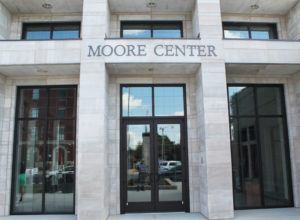
The Moore Center, a student center dedicated on Sept. 8, 2017, is a major presence on downtown Frederica Street.
In January 2002, Student Apartment II opened for occupancy. Brescia named Trustees Hall at February board meeting and received OMHS full-scholarship for pre-med students. In 2004, Brescia University dedicated the Fr. Leonard Alvey Library. Brescia University took action in 2005 to expand online offerings and agreement with The Learning House. The placement of the Joe Ford Library to Brescia campus was also being negotiated during this year. In 2007, Fr. Larry Hostetter was chosen as fifth President of Brescia University and the first non-Ursuline. H. Dean Jones also assumed chairmanship of Brescia University Board of Trustees. Brescia purchased Wilson House on 7th Street, completing acquisition of all property between Frederica Street and Allen Street. An independently supported, Catholic, coeducational institution, Brescia now offers undergraduate and graduate course work for career preparation firmly rooted in the liberal arts. Visit the Brescia website.
